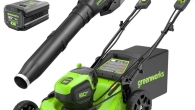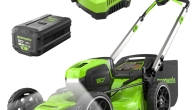
Why Is My Lawnmower Not Starting? Quick Fixes & Tips
Introduction
If you’re like many homeowners, the sight of a non-starting lawnmower can be frustrating, especially when you have a lawn that needs tending. A well-maintained lawn is not just about aesthetics; it also plays a role in maintaining the overall health of your property. When faced with the issue of a lawnmower that won’t start. It’s important to understand the potential causes and take the right steps to address them. In this article, we will explore some of the most common reasons why is my lawnmower not starting and provide you with quick fixes and tips to get it up and running again. Whether you are dealing with a gas-powered or an electric model. These troubleshooting techniques can help you save time and money, ensuring that your lawn stays in top condition.

Check the Fuel System
One of the most common reasons for a lawnmower not starting is a problem with the fuel system. If your lawnmower has been sitting idle for a while, the fuel may have gone stale. Old fuel can clog the carburetor and prevent the engine from starting. To check if this is the issue, first, inspect the fuel tank. If the fuel looks cloudy or has a strong smell, it’s likely old and should be drained. Replace it with fresh fuel, and add a fuel stabilizer to prevent future issues. Additionally, check the fuel filter and lines for any blockages.
A clogged fuel filter can restrict the flow of fuel to the carburetor, causing the engine to fail to start. If you find any blockages, clean or replace the filter as needed. For more advanced troubleshooting, you may need to clean the carburetor itself. This involves removing the carburetor, cleaning it with a carburetor cleaner, and reassembling it. If you are not comfortable doing this yourself, consider taking your lawnmower to a professional for service.
Battery and Electrical Issues
For electric and battery-powered lawnmowers, a dead or faulty battery can be the reason why your lawnmower is not starting. Start by checking the battery charge level. If the battery is completely discharged, plug it in and allow it to fully charge before attempting to start the lawnmower again. If the battery does not hold a charge, it may be time to replace it. Another common issue is a loose or corroded connection. Inspect the battery terminals and connections for any signs of corrosion or damage.
Clean the terminals with a wire brush and apply a small amount of petroleum jelly to prevent future corrosion. For corded electric mowers, ensure that the power cord is properly connected and that there are no breaks or frays in the cord. If the cord is damaged, it may need to be replaced. Finally, check the circuit breaker or fuse box to ensure that the outlet is receiving power. If the breaker has tripped, reset it and try starting the mower again.
Spark Plug Problems
A faulty spark plug is another common cause of a non-starting lawnmower. The spark plug ignites the fuel and air mixture in the combustion chamber, and if it is dirty, worn, or damaged, it can prevent the engine from starting. To check the spark plug, first, remove it using a spark plug socket. Inspect the electrode at the tip of the spark plug. If it appears blackened, oily, or worn, it should be replaced. You can also test the spark plug by attaching it to the ignition wire and grounding it against the engine block.

Pull the starter rope and observe if a spark jumps across the gap. If there is no spark, the spark plug is likely faulty and needs to be replaced. When replacing the spark plug, make sure to use the correct type and gap as specified in your lawnmower’s manual. A properly gapped and functioning spark plug can significantly improve the performance and reliability of your lawnmower.
Air Filter Clogging
The air filter is a crucial component of your lawnmower’s engine, as it prevents dirt and debris from entering the combustion chamber. Over time, the air filter can become clogged with dust and grass clippings, which can restrict airflow and cause the engine to stall or not start. To check the air filter, locate it on your lawnmower. It is usually housed in a plastic or metal case near the carburetor. Remove the cover and inspect the filter.
If it is dirty, you can clean it by tapping it gently to remove loose debris or washing it with soap and water. Allow the filter to dry completely before reinstalling it. If the filter is too dirty or damaged, it should be replaced. A clean air filter ensures that the engine receives the proper amount of air, which is essential for efficient combustion and smooth operation. Regularly checking and cleaning the air filter can also extend the life of your lawnmower and improve its overall performance.
Oil Level and Quality
Proper lubrication is essential for the smooth operation of your lawnmower’s engine. If the oil level is too low or the oil is contaminated, it can cause the engine to seize or not start. To check the oil level, locate the dipstick, which is typically found near the oil fill cap. Remove the dipstick, wipe it clean, and reinsert it. Then, pull it out again to read the oil level. If the oil level is below the “full” mark, add the appropriate type of oil until it reaches the correct level. Be careful not to overfill, as this can also cause issues.
Additionally, check the quality of the oil. If it appears dark, thick, or has a burnt smell, it may be contaminated and should be changed. Changing the oil is a simple process: drain the old oil, replace the oil filter (if applicable), and refill the crankcase with fresh oil. Regular oil changes, as recommended by the manufacturer, can help keep your lawnmower’s engine in top condition and prevent starting issues.
Blade and Deck Obstructions
Sometimes, the reason your lawnmower won’t start has nothing to do with the engine itself but rather with obstructions in the blade or deck. Debris such as sticks, rocks, and clumps of grass can get caught under the deck and prevent the blade from turning freely. This can cause the engine to stall or not start. To check for obstructions, first, ensure the lawnmower is turned off and the spark plug wire is disconnected. Tilt the mower on its side (with the air filter facing up) and inspect the underside of the deck.

Use a putty knife or a similar tool to remove any debris. While you have the mower tilted, also check the blade for any damage. A bent or dull blade can also cause starting issues. If the blade is damaged, it should be sharpened or replaced. A sharp, clean blade and a clear deck will ensure that your lawnmower operates smoothly and efficiently.
Regular Maintenance and Storage
Regular maintenance is key to keeping your lawnmower in good working condition and preventing starting issues. Some essential maintenance tasks include changing the oil, cleaning or replacing the air filter, and checking the spark plug. Additionally, storing your lawnmower properly during the off-season can help prevent issues. Before storing, empty the fuel tank or add a fuel stabilizer to prevent the fuel from going stale. Disconnect the spark plug wire to prevent accidental starts. Store the mower in a dry, sheltered area to protect it from the elements. By following these maintenance and storage tips, you can extend the life of your lawnmower and reduce the likelihood of starting problems.
Conclusion
A non-starting lawnmower can be a source of frustration, but with the right knowledge and tools, you can often resolve the issue quickly and easily. By checking the fuel system, battery, spark plug, air filter, oil level, and for any blade or deck obstructions, you can identify and fix the problem. Regular maintenance and proper storage are also crucial for keeping your lawnmower in top condition. If you’ve tried all the troubleshooting steps and your lawnmower still won’t start, it may be time to seek professional help. With these tips and tricks, you can get back to enjoying a well-manicured lawn in no time.












Leave a Reply